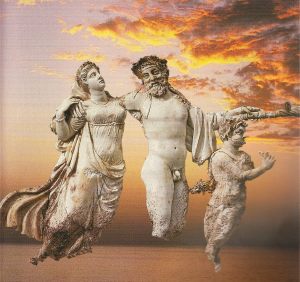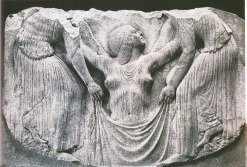The Creation Myth: How it All Began
The most detailed account of early classical Creation myths comes to us from Theogony, a poem composed by Hesiod, a Greek poet in the eighth century B.C. It is worthwhile to note that the central recurring theme in Hesiod's narration about the creation myth, is that the driving force behind progression from generation to generation of gods, is domination through conflict and war: From Uranus to Cronus and then from Cronus to Zeus, the power was violently seized from the successor who was challenging his predecessor's domination. This phenomenon is parallel to the radical changes that nature had to go through since the first time of creation, until it reached a phase of order and stability.
The Universe begins to take shape First, there was Chaos...As the Creation Myth goes, at the beginning of everything there was Chaos; this does not mean "Disorder" in the contemporary sense, but rather "Chasm", in the sense of a dark, gaping space.Afterwards came Gaia ("Earth") and Eros ("Sexual Love"), which personifies the driving principle behind all subsequent acts of procreation by which the cosmos became populated. Gaia was either born of Chaos or simply rising on its own. The Earth surrounded and engulfed Chaos. From where Chaos and Gaia came is neither explained nor elaborated. Hesiod simply states that they came first-and that the Earth came into being to serve as a solid foundation for the home of gods. From these first three (Chaos, Gaia and Eros) and the possible addition of Tartarus, a grim and terrifying region below the earth, there originated all that exists. [top] The Universe begins to take shapeFirst, came the few beings that were born through parthenogenesis that is the creation resulting from just one gender:
After the birth of Erebus, Nyx, Uranus and Pontus, virtually all of Creation came through mating. Uranus, the sky, emerged as big as his mother Gaia, so that he might envelop her-which he quickly did. Radiant with love for his Mother Earth, the Sky showered her with fertile rain. Gaia then gave birth to the rest of the physical world: the mountains, bodies of water, flora and fauna. Nyx mated with Erebus, producing a daughter, Hemera ("Day") and a son Aether ("Upper Air"). As the creation myth goes, Night and Day share a house, forever shrouded in darkness by the grim clouds of Tartarus. Yet they never stay in the same house together. Instead, they take turns, each waiting for the other to depart before crossing the bronze threshold and entering the house. Night also gave birth to another ominous breed of negative entities: Moros (Doom), Thanatos (Death), Hypnos (Sleep), Nemesis (a goddess of retribution), Eris (Strife), the Keres (female death spirits who would be charged with collecting and carrying off the bodies of the dead), and the three Moirai (Fates). Of these, the most interesting in terms of visual imagery were the Fates: Their names were Clotho, Lachesis and Atropos and each had her own function, but collectively they had the responsibility of determining the course of events in mortal lives-including the span of each life. Clotho ("the Spinner") would spin the thread of life of each mortal, Lachesis ("the Measurer") would measure the length with a rod and Atropos ("the Inflexible") would cut it with shears, thus ending it. [top] Titans and GiantsGaia and Uranus also brought forth other divinities, the most important of which in relation to the development of the rest of the Creation Myth, were the Titans (the "Overreachers").
The sons were named:
Though not as well known as the Titans who came after them, the first children of Gaia and Uranus were three giants: Cortus, Briareus and Gyges. Each of these brothers had 50 heads and 100 arms. These Hundred-Handed giants would be the mightiest of all Gaia's and Uranus's offspring. Their great strength and imposing presence caused even Titans and later Olympians to quake with fear. Gaia also lay with her other son Pontus ("Sea"). She gave birth to five children: Nereus, a sea god who would become known as the Old Man, was renowned for his truthfulness, gentle manner and fairness. Phorcys, another sea god and Thaumas were the brothers of Nereus. They also had two sisters: Ceto, a sea monster and Eyrybia. Nereus fathered fifty lovely sea nymphs in union with Doris, a daughter of Oceanus. Thaumas had a liaison with Electra, thus bringing forth the wind-swift Harpies and Iris, divine messenger and goddess of the rainbow. Phorcys lay with his sister Ceto, and they produced numerous monstrous creatures: Among them were the Graiai (women already old at birth), the Gorgons (one of them was Medusa) and the hideous Echidna, nymph above the waist and serpent below it. Echidna in turn would mate with Typhoeus, to produce Cerberus, Lerna Hydra, Orthos and Chimaira. Two more creatures, the Sphinx and the Nemean Lion would be the offspring of the mating between Orthos and Chimaira. Most of these creatures, play a significant role in the heroic exploits of the greek heroes Hercules, Perseus etc. Click here to get to know these heroes in more detail. The next children born to Gaia and Uranus were no less intimidating. They were the three Cyclopes: Brontes, Steropes and Arges. Each had only one eye, yet their enormous stature and mighty limbs more than made up for their limited vision. Inventive smiths and builders, they would become the forgers of thunder and lightning. [top] Uranus oppresses his childrenIn the development of the creation myth,Uranus proved to be not such a fatherly figure. Because of his being immortal, he never wanted his power to be diminished and pass the torch to the earlier generation, as is the case in the mortal world. Being intimidated by an oracle stating that he would be overthrown by one of his children, he performed some not so fatherly acts:First, in order to prevent the giants from becoming a threat, he hurled all of them (the Cyclopes and the Hundred Hand Giants) into the deepest recesses of Tartarus, condemning them to a life of imprisonment. As for the Titans, no sooner had Gaia given birth to one of these children, than Uranus thrust the baby back into the darkness of their mother's womb. Forcing his own children to remain in the deepest, darkest hollows of the Earth, Uranus refused to let them into the light again. As a result, all of his children hated Uranus with a passion. This was especially true in the case of Cronus, who could not wait for an opportunity to seize the power from his cruel father. [top] The castration of Uranus
Gaia grew very uncomfortable, with all her mighty children in her womb, condemned by Uranus. She thus devised a scheme to avenge her cruel husband: She crafted an enormous and very sharp sickle of iron. She then pleaded her children to take action to punish their father, but everyone was reluctant, except Cronus who volunteered to perform the horrible deed. When given the chance when Uranus was in a compromising position, Cronus severed his genitals with the iron and then hurled the castrated organ into the sea. In the sea, the organ bobbed on the water, giving rise to foam. As the myth goes, from this foam emerged the fully formed goddess of love: Aphrodite (whose name in Greek just means that, "emerging out of foam"). Naked and riding on a scallop shell, Aphrodite first touched land on the island of Cythera, but found the place too small for her comfort. Instead she stepped ashore on Cyprus. Learn all about Aphrodite by clicking here. From Uranus's severed manhood, fell countless drops of blood, which spattered all over Gaia. From this strange conception, Gaia bore many children, including:
[top] The New Generation of GodsAfter gaining their own freedom, the Titans made Cronus their king and freed the Cyclopes and their Hundred Handed brothers from Tartarus. However, due to their arrogant nature and their resistance to authority, the latter (Cyclopes and Giants) were soon thrown back to Tartarus by Cronus.As for the twelve titans, they retained their freedom and began pairing off, breeding a new generation of gods. Of the dozen, at least eight - four brothers and four sisters - married and had children:
[top] History Repeats ItselfAs lord of the immortals, Cronus became more of a tyrant than his father. His parents, Gaia and Uranus, had warned him when he first seized power, that one day he was destined to be overthrown by one of his sons. But Cronus relished his power and would not tolerate any potential challengers of his domination.To secure his power, he came up with a scheme that was even crueler than what his father conceived: Instead of burdening his wife with his children as his father did, he assumed the burden himself by swallowing each child, as soon as he or she emerged from his or her mother's womb. Filled with rage at her husband's unbelievable cruelty, Rhea pleaded with her parent's to devise a scheme to save her sixth child, Zeus, as soon as he was born. Gaia and Uranus, both being aware of the father and son destiny, quickly consented to help Rhea. Return from Creation Myth to Greek Pantheon
|
|||
Resource MaterialClassroom MaterialMovies,DVDs, Games and BooksAbout the SiteYour Stories |
|||
|
|
|||








